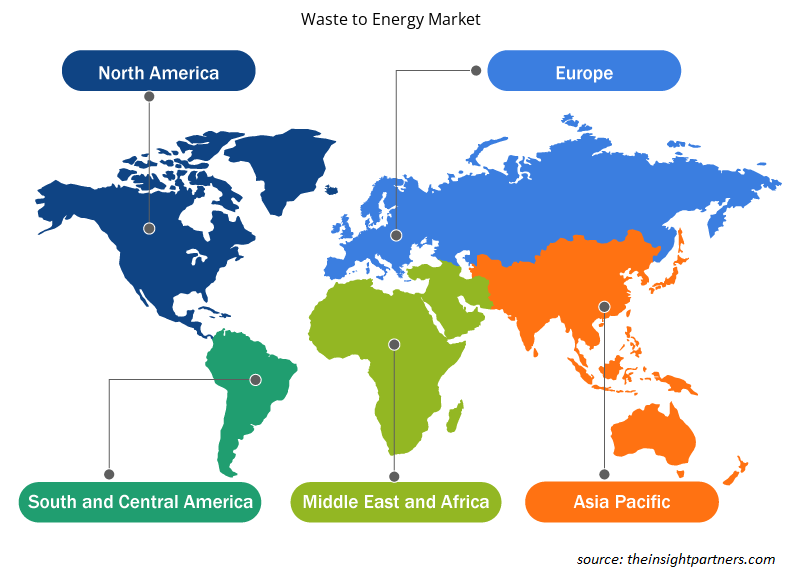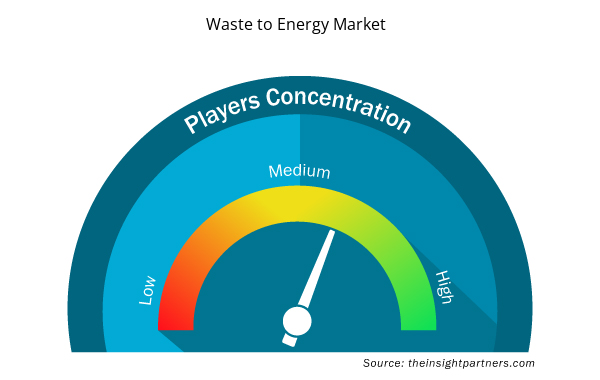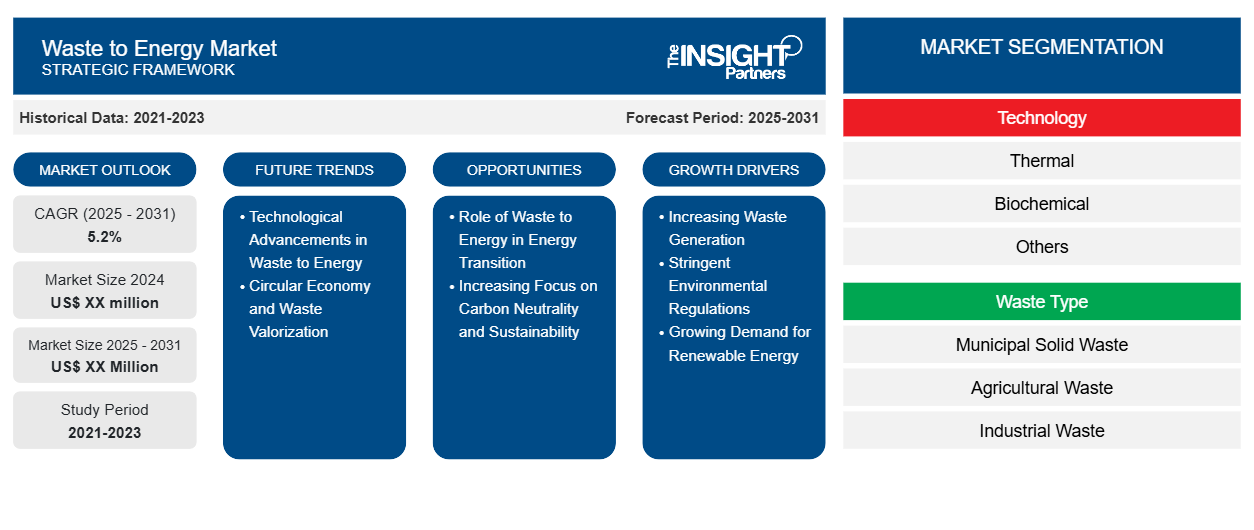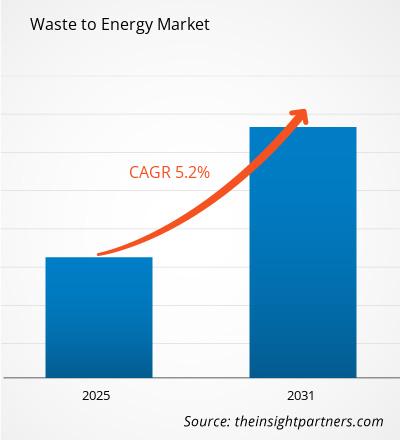من المتوقع أن يسجل سوق تحويل النفايات إلى طاقة معدل نمو سنوي مركب بنسبة 5.2٪ من عام 2023 إلى عام 2031، مع توسع حجم السوق من XX مليون دولار أمريكي في عام 2023 إلى XX مليون دولار أمريكي بحلول عام 2031.
تم تقسيم التقرير حسب التكنولوجيا (الحرارية، والكيميائية الحيوية، وغيرها). كما يقدم التقرير تحليلاً بناءً على نوع النفايات (النفايات الصلبة البلدية، والنفايات الزراعية، والنفايات الصناعية، وغيرها). كما يقدم التقرير تحليلاً بناءً على التطبيق (توليد الكهرباء، والتدفئة، والنقل). كما تم تقسيم التحليل العالمي على المستوى الإقليمي والدول الرئيسية. يقدم التقرير القيمة بالدولار الأمريكي للتحليل والقطاعات المذكورة أعلاه.
غرض التقرير
يهدف تقرير سوق تحويل النفايات إلى طاقة الصادر عن The Insight Partners إلى وصف المشهد الحالي والنمو المستقبلي وأهم العوامل الدافعة والتحديات والفرص. وسيوفر هذا رؤى لمختلف أصحاب المصلحة في الأعمال التجارية، مثل:
- مزودي/مصنعي التكنولوجيا: لفهم ديناميكيات السوق المتطورة ومعرفة فرص النمو المحتملة، وتمكينهم من اتخاذ قرارات استراتيجية مستنيرة.
- المستثمرون: إجراء تحليل شامل للاتجاهات فيما يتعلق بمعدل نمو السوق، وتوقعات السوق المالية، والفرص المتاحة عبر سلسلة القيمة.
- الهيئات التنظيمية: لتنظيم السياسات ومراقبة الأنشطة في السوق بهدف تقليل الانتهاكات والحفاظ على ثقة المستثمرين ودعم سلامة السوق واستقرارها.
تجزئة سوق تحويل النفايات إلى طاقة
تكنولوجيا
- حراري
- الكيمياء الحيوية
- آحرون
نوع النفايات
- النفايات الصلبة البلدية
- النفايات الزراعية
- النفايات الصناعية
- آحرون
طلب
- توليد الكهرباء
- التدفئة
- مواصلات
الجغرافيا
- أمريكا الشمالية
- أوروبا
- آسيا والمحيط الهادئ
- أمريكا الجنوبية والوسطى
- الشرق الأوسط وأفريقيا
الجغرافيا
- أمريكا الشمالية
- أوروبا
- آسيا والمحيط الهادئ
- أمريكا الجنوبية والوسطى
- الشرق الأوسط وأفريقيا
قم بتخصيص هذا التقرير ليناسب متطلباتك
ستحصل على تخصيص لأي تقرير - مجانًا - بما في ذلك أجزاء من هذا التقرير، أو تحليل على مستوى الدولة، وحزمة بيانات Excel، بالإضافة إلى الاستفادة من العروض والخصومات الرائعة للشركات الناشئة والجامعات
- احصل على أهم اتجاهات السوق الرئيسية لهذا التقرير.ستتضمن هذه العينة المجانية تحليلاً للبيانات، بدءًا من اتجاهات السوق وحتى التقديرات والتوقعات.
عوامل نمو سوق تحويل النفايات إلى طاقة
- زيادة توليد النفايات: مع زيادة أعداد السكان الحضريين والاقتصادات الصناعية على مستوى العالم، فإن كمية النفايات المتولدة تتزايد باستمرار. وتتزايد الضغوط على مكبات النفايات وأنظمة الإدارة القديمة للنفايات جنبًا إلى جنب مع هذا الاتجاه المتزايد. وبالتالي توفر تقنية WtE إجابة على التحدي الحاسم الذي تفرضه النفايات المتزايدة باستمرار، وتنتج الكهرباء في نفس الوقت. ومع ازدحام مكبات النفايات وتشديد اللوائح حول التخلص من النفايات، أصبح تحويل النفايات إلى طاقة البديل المفضل، مما ساهم في نمو سوق WtE.
- اللوائح البيئية الصارمة: تفرض الحكومات في جميع أنحاء العالم لوائح بيئية أكثر صرامة للسيطرة على التأثير البيئي لممارسات إدارة النفايات. يتم حظر أو تنظيم التقنيات القديمة مثل طمر النفايات وحرقها دون استعادة الطاقة بشكل متزايد لأنها تسبب تدهورًا بيئيًا مع تأثيرات ضارة على تلوث التربة وانبعاث غاز الميثان. تحفز اللوائح تقنيات WtE على سد هذه الفجوة لأنها تساعد في تقليل حجم النفايات وخفض الانبعاثات ودعم هدف الحد من الكربون وبالتالي تحفيز الطلب على حلول WtE.
- الطلب المتزايد على الطاقة المتجددة: هناك تحول عالمي متزايد نحو مصادر الطاقة المتجددة حيث تسعى البلدان إلى تحقيق أهدافها المناخية والحد من الاعتماد على الوقود الأحفوري. يعتبر تحويل النفايات إلى طاقة مصدرًا للطاقة المتجددة لأنه يقلل من النفايات أثناء توليد الكهرباء أو الحرارة أو الوقود. أدى التركيز المتزايد على تبني الطاقة المتجددة، جنبًا إلى جنب مع الحاجة إلى تنويع مصادر الطاقة، إلى خلق طلب قوي على تقنيات تحويل النفايات إلى طاقة. وبالتالي، فإن تحويل النفايات إلى طاقة هو أحد الحلول الواعدة التي يمكن استخدامها بالاشتراك مع مصادر متجددة أخرى مثل الطاقة الشمسية وطاقة الرياح والطاقة الكهرومائية.
الاتجاهات المستقبلية لسوق تحويل النفايات إلى طاقة
- التطورات التكنولوجية في تحويل النفايات إلى طاقة: لقد فتحت التطورات الأخيرة في تكنولوجيات تحويل النفايات إلى طاقة، بما في ذلك التكنولوجيات الحرارية المتقدمة مثل التحلل الحراري والتغويز، والعمليات البيولوجية، مثل الهضم اللاهوائي، فرصاً مهمة في السوق. أصبحت هذه التكنولوجيات فعالة وفعّالة من حيث التكلفة وصديقة للبيئة. على سبيل المثال، يتم استكشاف التغويز بشكل أكبر لأنه يمكن أن يحول المزيد من مواد النفايات إلى وقود أو كهرباء أفضل، والهضم اللاهوائي هو وسيلة واعدة أخرى لتحويل النفايات العضوية إلى غاز حيوي. كما تفتح الابتكارات في مجال احتجاز الكربون وكفاءة الطاقة آفاقاً جديدة للنمو في قطاع تحويل النفايات إلى طاقة.
- الاقتصاد الدائري وتثمين النفايات: يكتسب مفهوم الاقتصاد الدائري، الذي يتم بموجبه إعادة استخدام المنتجات والمواد وإصلاحها وإعادة تدويرها، زخمًا كبيرًا في جميع أنحاء العالم. وبالتالي فإن تقنيات تحويل النفايات إلى طاقة تتناسب بشكل جيد مع هذا المخطط، حيث إنها لا تساعد فقط في معالجة قضية التخلص من النفايات، بل إنها تولد أيضًا الطاقة والمنتجات الثانوية القيمة مثل الوقود الحيوي والمواد الكيميائية والحرارة. وقد اكتسبت عملية تثمين النفايات أو تعظيم قيمتها اهتمامًا أكبر، مما أدى إلى خلق إمكانات كبيرة لسوق تحويل النفايات إلى طاقة. تمتلك محطات تحويل النفايات إلى طاقة قدرات توليد الطاقة وإدارة النفايات وبالتالي تلعب دورًا كبيرًا في الاقتصاد الدائري.
فرص سوق تحويل النفايات إلى طاقة
- دور تحويل النفايات إلى طاقة في التحول في مجال الطاقة: التحول في مجال الطاقة هو التحول من الاعتماد على الوقود الأحفوري إلى مصادر الطاقة المتجددة والنظيفة. ويعالج هذا التغيير الحاجة الملحة إلى حلول طاقة مستدامة وصديقة للبيئة. وقد شهدت العقود الأخيرة زيادة في انبعاثات ثاني أكسيد الكربون (CO2)، مما ساهم في تغير المناخ. ويعد التحول إلى مصادر الطاقة المتجددة والصديقة للبيئة استراتيجية حاسمة للحد من هذه الانبعاثات والتخفيف من الأضرار البيئية. ومن المتوقع أن يكون هذا التحول في الطاقة عن طريق تحويل النفايات إلى طاقة أو وقود هو الاتجاه المستقبلي الرئيسي في سوق تحويل النفايات إلى طاقة في السنوات القادمة.
- التركيز المتزايد على الحياد الكربوني والاستدامة: يشكل هذا التركيز جزءًا من الجهود الدولية الرامية إلى تحقيق أهداف المناخ العالمية، ويزداد وضوحًا من خلال الحياد الكربوني وحلول الطاقة المستدامة. تساعد تقنيات تحويل النفايات إلى طاقة في الحد من انبعاثات الغازات المسببة للانحباس الحراري العالمي من خلال تحويل النفايات بعيدًا عن مكبات النفايات، مما يقلل من انبعاثات غاز الميثان، وتوليد الطاقة النظيفة. ستزيد الشركات والبلدان التي تضع أهدافًا طموحة للاستدامة من الطلب على حلول تحويل النفايات إلى طاقة. ستكون تقنيات تحويل النفايات إلى طاقة المجهزة لالتقاط الكربون وحجزه أكثر إقناعًا كجزء من استراتيجية متكاملة للتخفيف من آثار تغير المناخ.
رؤى إقليمية حول سوق تحويل النفايات إلى طاقة
لقد قام المحللون في Insight Partners بشرح الاتجاهات والعوامل الإقليمية المؤثرة على سوق تحويل النفايات إلى طاقة طوال فترة التوقعات بشكل شامل. يناقش هذا القسم أيضًا قطاعات سوق تحويل النفايات إلى طاقة والجغرافيا في جميع أنحاء أمريكا الشمالية وأوروبا ومنطقة آسيا والمحيط الهادئ والشرق الأوسط وأفريقيا وأمريكا الجنوبية والوسطى.

- احصل على البيانات الإقليمية المحددة لسوق تحويل النفايات إلى طاقة
نطاق تقرير سوق تحويل النفايات إلى طاقة
| سمة التقرير | تفاصيل |
|---|---|
| حجم السوق في عام 2023 | XX مليون دولار أمريكي |
| حجم السوق بحلول عام 2031 | XX مليون دولار أمريكي |
| معدل النمو السنوي المركب العالمي (2023 - 2031) | 5.2% |
| البيانات التاريخية | 2021-2022 |
| فترة التنبؤ | 2024-2031 |
| القطاعات المغطاة | حسب التكنولوجيا
|
| المناطق والدول المغطاة | أمريكا الشمالية
|
| قادة السوق وملفات تعريف الشركات الرئيسية |
|
كثافة اللاعبين في سوق تحويل النفايات إلى طاقة: فهم تأثيرها على ديناميكيات الأعمال
يشهد سوق تحويل النفايات إلى طاقة نموًا سريعًا، مدفوعًا بالطلب المتزايد من المستخدم النهائي بسبب عوامل مثل تفضيلات المستهلكين المتطورة والتقدم التكنولوجي والوعي المتزايد بفوائد المنتج. ومع ارتفاع الطلب، تعمل الشركات على توسيع عروضها والابتكار لتلبية احتياجات المستهلكين والاستفادة من الاتجاهات الناشئة، مما يؤدي إلى زيادة نمو السوق.
تشير كثافة اللاعبين في السوق إلى توزيع الشركات أو المؤسسات العاملة في سوق أو صناعة معينة. وهي تشير إلى عدد المنافسين (اللاعبين في السوق) الموجودين في مساحة سوق معينة نسبة إلى حجمها أو قيمتها السوقية الإجمالية.
الشركات الرئيسية العاملة في سوق تحويل النفايات إلى طاقة هي:
- مجموعة AEandE المحدودة
- شركة أرو إيكولوجي المحدودة
- شركة بابكوك وويلكوكس إنتربرايزز المحدودة
- شركة الإنشاءات الصناعية De La Mediterranee SA
- شركة كوفانتا للطاقة
إخلاء المسؤولية : الشركات المذكورة أعلاه ليست مرتبة بأي ترتيب معين.

- احصل على نظرة عامة على أهم اللاعبين الرئيسيين في سوق تحويل النفايات إلى طاقة
نقاط البيع الرئيسية
- التغطية الشاملة: يغطي التقرير بشكل شامل تحليل المنتجات والخدمات والأنواع والمستخدمين النهائيين لسوق تحويل النفايات إلى طاقة، مما يوفر صورة شاملة.
- تحليل الخبراء: تم تجميع التقرير على أساس الفهم العميق لخبراء الصناعة والمحللين.
- معلومات محدثة: يضمن التقرير أهمية الأعمال التجارية بسبب تغطيته للمعلومات الحديثة واتجاهات البيانات.
- خيارات التخصيص: يمكن تخصيص هذا التقرير لتلبية متطلبات العملاء المحددة وبما يتناسب مع استراتيجيات العمل بشكل مناسب.
وبالتالي، فإن تقرير البحث حول سوق تحويل النفايات إلى طاقة يمكن أن يساعد في تمهيد الطريق لفك شفرة وفهم سيناريو الصناعة وآفاق النمو. ورغم وجود بعض المخاوف المشروعة، فإن الفوائد الإجمالية لهذا التقرير تميل إلى التفوق على العيوب.
- التحليل التاريخي (سنتان)، السنة الأساسية، التوقعات (7 سنوات) مع معدل النمو السنوي المركب
- تحليل PEST و SWOT
- حجم السوق والقيمة / الحجم - عالميًا وإقليميًا وقطريًا
- الصناعة والمنافسة
- مجموعة بيانات Excel


- Underwater Connector Market
- Single-Use Negative Pressure Wound Therapy Devices Market
- Public Key Infrastructure Market
- Cell Line Development Market
- Maritime Analytics Market
- Foot Orthotic Insoles Market
- Electronic Shelf Label Market
- Compounding Pharmacies Market
- Equipment Rental Software Market
- Energy Recovery Ventilator Market

Report Coverage
Revenue forecast, Company Analysis, Industry landscape, Growth factors, and Trends

Segment Covered
This text is related
to segments covered.

Regional Scope
North America, Europe, Asia Pacific, Middle East & Africa, South & Central America

Country Scope
This text is related
to country scope.
الأسئلة الشائعة
Some of the customization options available based on the request are an additional 3-5 company profiles and country-specific analysis of 3-5 countries of your choice. Customizations are to be requested/discussed before making final order confirmation, as our team would review the same and check the feasibility.
The report can be delivered in PDF/PPT format; we can also share excel dataset based on the request.
The leading players operating in the Waste to Energy Market include Mitsubishi Heavy Industries Ltd., A2A S.p.A., Veolia Environnement SA, Martin GmbH, Hitachi Zosen Corp., Ramboll Group A/S, EEW Holding GmbH, Tana Oy, SUEZ, STEAG Energy Services GmbH
Technological Advancements in Waste to Energy is the key future trend of the Waste to Energy Market
The Waste to Energy Market is estimated to witness a CAGR of 5.2% from 2023 to 2031
The major factors driving the Waste to Energy Market are: Increasing Waste Generation and Stringent Environmental Regulations
Trends and growth analysis reports related to Energy and Power : READ MORE..
1. AEandE Group Gmbh2. Arrow Ecology Limited3. Babcock and Wilcox Enterprises Inc.4. Constructions Industrielles De La Mediterranee S.A.5. Covanta Energy Corporation6. Essent N.V.7. Haase Energietechnik AG8. John Wood Group PLC9. Pacific Renewable Fuels Inc10. Qinetiq Group Plc
The Insight Partners performs research in 4 major stages: Data Collection & Secondary Research, Primary Research, Data Analysis and Data Triangulation & Final Review.
- Data Collection and Secondary Research:
As a market research and consulting firm operating from a decade, we have published and advised several client across the globe. First step for any study will start with an assessment of currently available data and insights from existing reports. Further, historical and current market information is collected from Investor Presentations, Annual Reports, SEC Filings, etc., and other information related to company’s performance and market positioning are gathered from Paid Databases (Factiva, Hoovers, and Reuters) and various other publications available in public domain.
Several associations trade associates, technical forums, institutes, societies and organization are accessed to gain technical as well as market related insights through their publications such as research papers, blogs and press releases related to the studies are referred to get cues about the market. Further, white papers, journals, magazines, and other news articles published in last 3 years are scrutinized and analyzed to understand the current market trends.
- Primary Research:
The primarily interview analysis comprise of data obtained from industry participants interview and answers to survey questions gathered by in-house primary team.
For primary research, interviews are conducted with industry experts/CEOs/Marketing Managers/VPs/Subject Matter Experts from both demand and supply side to get a 360-degree view of the market. The primary team conducts several interviews based on the complexity of the markets to understand the various market trends and dynamics which makes research more credible and precise.
A typical research interview fulfils the following functions:
- Provides first-hand information on the market size, market trends, growth trends, competitive landscape, and outlook
- Validates and strengthens in-house secondary research findings
- Develops the analysis team’s expertise and market understanding
Primary research involves email interactions and telephone interviews for each market, category, segment, and sub-segment across geographies. The participants who typically take part in such a process include, but are not limited to:
- Industry participants: VPs, business development managers, market intelligence managers and national sales managers
- Outside experts: Valuation experts, research analysts and key opinion leaders specializing in the electronics and semiconductor industry.
Below is the breakup of our primary respondents by company, designation, and region:

Once we receive the confirmation from primary research sources or primary respondents, we finalize the base year market estimation and forecast the data as per the macroeconomic and microeconomic factors assessed during data collection.
- Data Analysis:
Once data is validated through both secondary as well as primary respondents, we finalize the market estimations by hypothesis formulation and factor analysis at regional and country level.
- Macro-Economic Factor Analysis:
We analyse macroeconomic indicators such the gross domestic product (GDP), increase in the demand for goods and services across industries, technological advancement, regional economic growth, governmental policies, the influence of COVID-19, PEST analysis, and other aspects. This analysis aids in setting benchmarks for various nations/regions and approximating market splits. Additionally, the general trend of the aforementioned components aid in determining the market's development possibilities.
- Country Level Data:
Various factors that are especially aligned to the country are taken into account to determine the market size for a certain area and country, including the presence of vendors, such as headquarters and offices, the country's GDP, demand patterns, and industry growth. To comprehend the market dynamics for the nation, a number of growth variables, inhibitors, application areas, and current market trends are researched. The aforementioned elements aid in determining the country's overall market's growth potential.
- Company Profile:
The “Table of Contents” is formulated by listing and analyzing more than 25 - 30 companies operating in the market ecosystem across geographies. However, we profile only 10 companies as a standard practice in our syndicate reports. These 10 companies comprise leading, emerging, and regional players. Nonetheless, our analysis is not restricted to the 10 listed companies, we also analyze other companies present in the market to develop a holistic view and understand the prevailing trends. The “Company Profiles” section in the report covers key facts, business description, products & services, financial information, SWOT analysis, and key developments. The financial information presented is extracted from the annual reports and official documents of the publicly listed companies. Upon collecting the information for the sections of respective companies, we verify them via various primary sources and then compile the data in respective company profiles. The company level information helps us in deriving the base number as well as in forecasting the market size.
- Developing Base Number:
Aggregation of sales statistics (2020-2022) and macro-economic factor, and other secondary and primary research insights are utilized to arrive at base number and related market shares for 2022. The data gaps are identified in this step and relevant market data is analyzed, collected from paid primary interviews or databases. On finalizing the base year market size, forecasts are developed on the basis of macro-economic, industry and market growth factors and company level analysis.
- Data Triangulation and Final Review:
The market findings and base year market size calculations are validated from supply as well as demand side. Demand side validations are based on macro-economic factor analysis and benchmarks for respective regions and countries. In case of supply side validations, revenues of major companies are estimated (in case not available) based on industry benchmark, approximate number of employees, product portfolio, and primary interviews revenues are gathered. Further revenue from target product/service segment is assessed to avoid overshooting of market statistics. In case of heavy deviations between supply and demand side values, all thes steps are repeated to achieve synchronization.
We follow an iterative model, wherein we share our research findings with Subject Matter Experts (SME’s) and Key Opinion Leaders (KOLs) until consensus view of the market is not formulated – this model negates any drastic deviation in the opinions of experts. Only validated and universally acceptable research findings are quoted in our reports.
We have important check points that we use to validate our research findings – which we call – data triangulation, where we validate the information, we generate from secondary sources with primary interviews and then we re-validate with our internal data bases and Subject matter experts. This comprehensive model enables us to deliver high quality, reliable data in shortest possible time.


 احصل على عينة مجانية لهذا التقرير
احصل على عينة مجانية لهذا التقرير